Nanotechnology- the Small Science Making a Big Deal
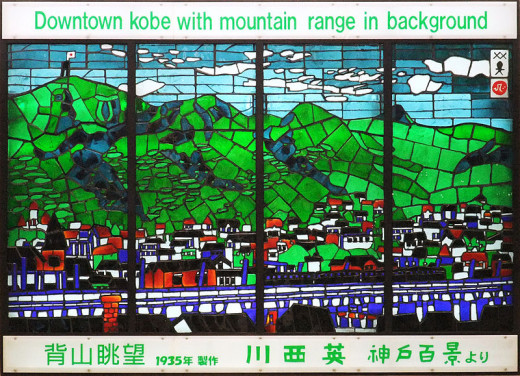
Suffix
| Relation to Meter
| Multiplier
|
|---|---|---|
Giga
| 10^9
| 1,000,000,000 M
|
Mega
| 10^6
| 1,000,000 M
|
Kilo
| 10^3
| 1000 M
|
METER
| BASIC UNIT
| LENGTH
|
Deci
| 10^-1
| 0.1 M
|
Centi
| 10^-2
| 0.01 M
|
Milli
| 10^-3
| 0.001 M
|
Micro
| 10^-6
| 0.000001 M
|
Nano
| 10^-9
| 0.000000001 M
|
Pico
| 10^-12
| 1 x 10 -12 M
|
Femto
| 10^-15
| 1 x 10 -15 M
|
Nanotechnology is quite the buzz word these days. It is all over the news dealing with a wide range of topics- engineering, computer technology, agriculture, and medicine. A great resource on this topic is the National Nanotechnology Initiative , which is where I started out.
The major point describing Nanotechnology (NT) is it encompasses any materials where at least one dimension is within the nanoscale. The intriguing thing about the nanoscale is materials on this scale can display different properties than they would when made on larger scales. A few major points regarding nanotechnology are as follows, first- nanotech isn’t new, the notion has been around since 1959 but recent advances in microscopy have allowed for researchers to better utilize the nanoscale. Ultimately this technology platform is not only about the visualization of these microscopic materials but the manipulation of them as well which wouldn’t be possible without these microscopy advances in the mid-1980s. It is a very broad reaching technology platform; examples include advances in computer memory and speed, medical diagnostics, and materials science. Lastly the most important point to be made about this work is what makes nanomaterials so unique. The molecules and atoms that make up the world, display different qualities when constructed on the nanoscale than they do at larger scales. These qualities are tunable based on the size and shape constructed, which is why it is not only the visualization but manipulation aspect of this technology that is key.
Examples of nanoscale materials
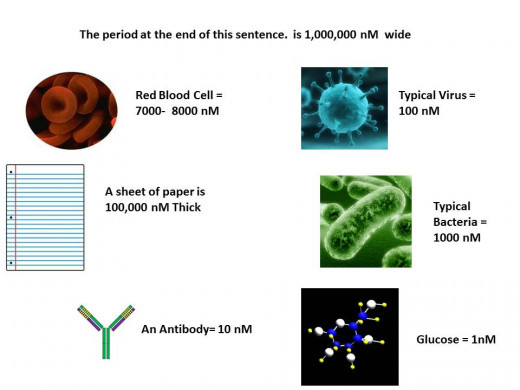
Let’s first take a look at these tunable, unique properties of materials in the nanoscale because they are critical to truly understanding the impact nanotechnology can have on all of these different applications. Materials existing in the nanoscale, whether they are naturally occurring or produced in a laboratory setting, have unique properties due to their size. The same materials constructed outside of the nanoscale (with dimensions utilizing a larger scale, millimeters for example) may not have the same properties. These properties include-but are not limited to- reactivity, color, strength, and conductivity. The reasons for these differences are pretty complex- dealing with the likes of quantum mechanics and electromagnetics. Gravitational forces govern macroscale materials because of their mass, but since mass is negligible in nanoscale materials other forces rule. Electromagnetics- the energy of electrically charged particles, including electrons, is the major player at the nanoscale, along with quantum mechanics- the dealings of properties at the atomic and subatomic level. But the take home is when the size of a material is on the nanoscale interactions within the material are under a different set of rules due to the compaction and confinement the components are under. The most common example is the color of gold compared at the nanoscale and the larger scale. Contrary to its name, on the nanoscale gold is actually red or green due to its altered light reactivity. Now while this looks pretty, as seen in the above stained-glass image which is the earliest example of nanotechnology, there are many other properties that have a huge impact on the wide world of science.
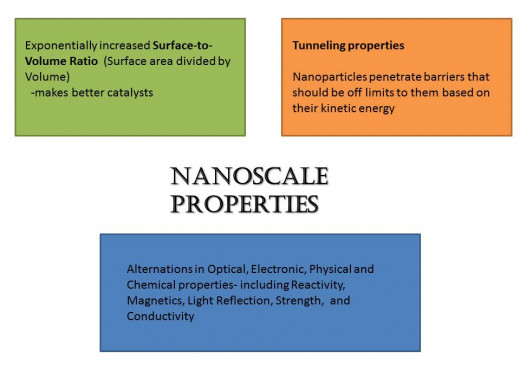
As mentioned above the definition of nanotechnology is the use of material where one of its dimensions is within the nanoscale. Some examples of these are nanotubes, nanoparticles, and nanofilms- all working in the nanoscale but with varying shapes. The most common example of a nanotube is the carbon nanotube, composed of single sheets of graphene rolled into a tube. Graphene itself is a single sheet of graphite, composed of carbon atoms arranged in a hexagonal configuration. These carbon structures are all known as allotropes, all are made up from carbon atoms but differ in the way that the atoms are bonded together. Carbon nanotubes, graphene, and graphite are all thermal conductors-the characteristic of interest in nanotech. This group of allotropes of carbon also includes fullerene, which is also known as a buckyball with a configuration of carbons that gives a hollow, cage-like structure. Nanoparticles are nanomaterials that can be made up of metals, oxides, or semiconductors all having exploits on the nanoscale that allow them to function in a variety of applications. These are often classified further to be called nanoshells or nanorods based on their orientation. As the name implies nanorods are cylindrical and solid as well, while nanoshells have a core of various materials coated by the metal of choice. In the case of gold nanoshells the core is generally silica surrounding by a coating of gold. Nanofilms are an interesting group with applications in a diverse group of technologies. These films have a thickness in the nanoscale range and are generally arranged in multiple layers. Many have the ability to self assembly when all of the necessary components are put together. They are being looked into for drug delivery techniques as well incorporation into lithium ion batteries for improved energy capacity.
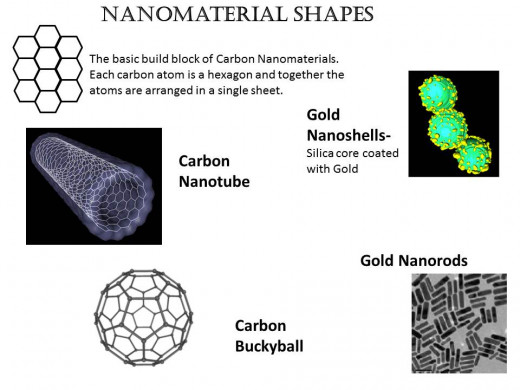
Sticking with gold as an example gives countless therapeutic avenues including drug delivery, drug therapy, and diagnostics. As mentioned above, gold nanoparticles display unique optical characteristics when compared to larger counterparts. These optical characteristics can be utilized for detection and therapeutic use, while the increased surface to volume ratio makes these nanoparticles a great drug delivery tool when conjugated to a drug. This surface to volume ratio can also be used to coat the nanoparticles in something to better suit them for their journey through the body, allowing the particles to avoid detection and elimination from the body. Gold nanoparticles have been shown to kill tumor cells when the particles are introduced to the cells and a light source-radio waves, microwaves or ultrasound- is presented. The light excites the gold particles and they produce enough heat to kill the cells, this is known as hyperthermia therapy.
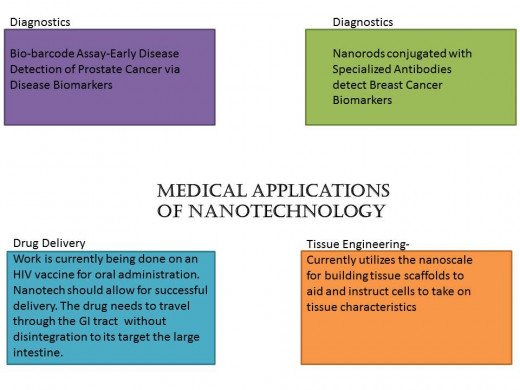
Hyperthermia therapy on its own has been used for cancer therapy for some time now; the addition of nanoparticles increases the effectiveness of this procedure. Injecting nanoparticles allows for targeting even more so to tumor cells only, leaving out normal tissue. Traditionally this type of treatment has been used to contain the size of tumors, strictly as a palliative method. But now the addition of nanoparticles has been found to make the tumor cells more susceptible to conventional cancer treatment- chemotherapy or radiation- so when used in conjugation can go towards a more curative therapy. In addition to gold nanoparticles, iron oxide NPs, and even carbon nanotubes are being looked into for nanoparticle/hyperthermia therapy. Iron oxide NPs are referred to as SPIONS as in SuperParamagnetic Iron Oxide Nanoparticles. On the nanoscale iron oxide’s magnetic properties are different than on the macroscale. On the macroscale they are permanent magnets but on the nanoscale they are paramagnetic because they require an outside magnetic field. When magnetized by alternating magnetic fields these nanoparticles will lose energy in the form of heat; blast a tumor cell with enough of these NPs, and we are talking tens of billions, expose to the magnetic fields and there will be enough heat generated to damage the tumor cells. Hyperthermia therapy is just one of the many avenues nanoparticles can be used. Overall nanotech is on schedule to contribute greatly to diagnostics as well as therapeutics.
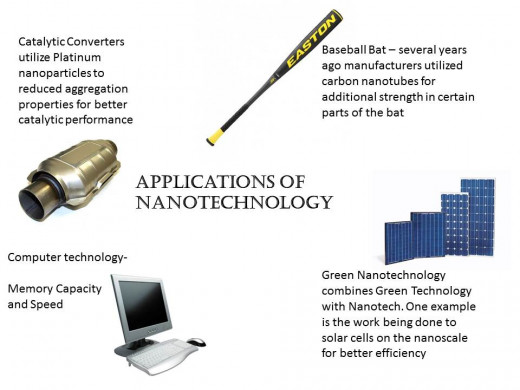
Nanotechnology is something that has been going on behind the scenes in virtually every field of science and technology for years now. But word is getting out. The field will continue to advance as technology-based discoveries are made, allowing for better visualization and manipulation of nanoparticles. This will aid in the construction of new nanoparticles with never-ending possibilities in engineering and science. Not to mention everyday products like sporting equipment, batteries, and auto parts. As the technology continues to catch up with the theory and thinking turns into achieving we will hear so much more about nanotech as the months and years go on. In fact, nanotech is estimated to be represented in 15% of globally manufactured goods by the year 2014.
Source available on request








